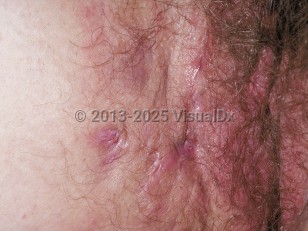Crohn disease - Anogenital in
See also in: Overview,Oral Mucosal LesionAlerts and Notices
Important News & Links
Synopsis
Symptoms from Crohn disease can vary considerably, both due to location but also to the severity of disease involvement. Patients may present with abdominal pain, bloody or nonbloody diarrhea, weight loss or malnutrition, fistulas, abscesses (often perianal), dysphagia, or oral ulcerations. Additionally, Crohn disease has many extraintestinal manifestations that can at times be the presenting symptoms. These manifestations can involve joints, skin, eyes, vasculature, the lungs, or the kidneys.
Crohn disease may involve the vulva and groin in 22%-44% of cases, either primarily or secondarily. Granulomatous infiltration of genital skin may compress lymphatics, leading to lymphedema of the vulva. Linear ulceration or aphthae may be present. True fistulas may occur. Hidradenitis suppurativa may be associated.
Crohn disease presents most typically in the second to fourth decades of life, with a slight female predominance. While no clear genetic mutation is linked to the development of Crohn disease, there are many genetic mutations that are associated with Crohn disease. For unclear reasons, Crohn disease is more prevalent at higher latitudes and in certain patient populations, namely individuals of Ashkenazi Jewish descent and individuals of Northern European descent in the United States.
Codes
K50.918 – Crohn's disease, unspecified, with other complication
SNOMEDCT:
34000006 – Crohn's disease
Look For
Subscription Required
Diagnostic Pearls
Subscription Required
Differential Diagnosis & Pitfalls

Subscription Required
Best Tests
Subscription Required
Management Pearls
Subscription Required
Therapy
Subscription Required
Drug Reaction Data
Subscription Required
References
Subscription Required
Last Updated:02/29/2024

